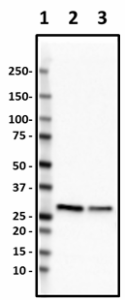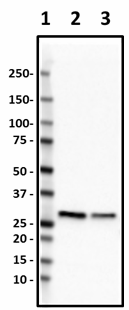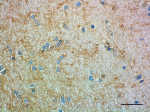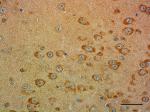- Clone
- Poly28615 (See other available formats)
- Regulatory Status
- RUO
- Other Names
- 26S proteasome non-ATPase regulatory subunit 9, 26S proteasome regulatory subunit p27, Proteasome 26S Subunit, Non-ATPase 9, Homolog of Rat Bridge 1, Rpn4, P27
- Isotype
- Rabbit Polyclonal IgG
- Ave. Rating
- Submit a Review
- Product Citations
- publications

-

Western blot of purified anti-PSMD9 antibody (clone Poly28615). Lane 1: Molecular weight marker; Lane 2: 20 µg of human brain lysate; Lane 3: 20 µg of mouse brain lysate. The blot was incubated with 0.5 µg/mL of the primary antibody overnight at 4°C, followed by incubation with HRP-labeled donkey anti-rabbit IgG (Cat. No. 406401). Enhanced chemiluminescence was used as the detection system. -

Western blot of purified anti-PSMD9 antibody (clone Poly28615). Lane 1: Molecular weight marker; Lane 2: 20 µg of Drosophila head lysate. The blot was incubated with 5 µg/mL of the primary antibody overnight at 4°C, followed by incubation with HRP-labeled donkey anti-rabbit IgG (Cat. No. 406401). Enhanced chemiluminescence was used as the detection system. -

IHC staining of purified anti-PSMD9 antibody (clone Poly28615) on formalin-fixed paraffin-embedded human brain tissue. Following antigen retrieval using Sodium Citrate H.I.E.R., the tissue was incubated with 5 µg/mL of the primary antibody overnight at 4°C. BioLegend's Ultra Streptavidin (USA) HRP Detection Kit (Multi-Species, DAB, Cat. No. 929901) was used for detection followed by hematoxylin counterstaining, according to the protocol provided. The image was captured with a 40X objective. Scale bar: 50 µm -

IHC staining of purified anti-PSMD9 antibody (clone Poly28615) on formalin-fixed paraffin-embedded mouse brain tissue. Following antigen retrieval using Sodium Citrate H.I.E.R., the tissue was incubated with 10 µg/mL of the primary antibody overnight at 4°C. BioLegend's Ultra Streptavidin (USA) HRP Detection Kit (Multi-Species, DAB, Cat. No. 929901) was used for detection followed by hematoxylin counterstaining, according to the protocol provided. The image was captured with a 40X objective. Scale bar: 50 µm
| Cat # | Size | Price | Quantity Check Availability | Save | ||
|---|---|---|---|---|---|---|
| 861501 | 25 µg | 100€ | ||||
The ubiquitin proteasome system (UPS) is one of the major protein degradation and clearance pathways in eukaryotic cells. Defects in the UPS system lead to a variety of diseases. The 26S proteasome is composed of a proteolytically active 20S proteasome core particle (CP) and a 19S proteasome regulatory particle (RP). The RP is responsible for substrate binding, unfolding, translocation to the proteolytical chamber of CP and release of ubiquitin from the substrate.
PSMD9, also known as p27, is a subunit of the modulator trimer complex that facilitates the association of PA700 regulator with the 20S proteasome CP to form the ATP-dependent active 26S proteasome. PSMD9 is ubiquitously expressed and is particularly abundant in the liver and kidney. PSMD9 has been implicated in variety of diseases including neurodegeneration, cancer, diabetes, and mental health disorders.
Product Details
- Verified Reactivity
- Human, Mouse, Drosophila
- Antibody Type
- Polyclonal
- Host Species
- Rabbit
- Immunogen
- Recombinant PSMD9 (Ser2-Arg223)
- Formulation
- 0.01 M PBS, pH7.4, containing 0.02% NaN3, 50% glycerol.
- Preparation
- The antibody was purified by affinity chromatography.
- Concentration
- 0.5 mg/ml
- Storage & Handling
- Store at 4°C for up to 3 months. For longer term storage aliquot into small volumes and store at -20°C
- Application
-
WB - Quality tested
IHC-P - Verified - Recommended Usage
-
Each lot of this antibody is quality control tested by Western blotting. For Western blotting, the suggested use of this reagent is 0.5 - 5 µg per ml for human and mouse and 5.0 - 10 µg per ml for Drosophila. For immunohistochemistry on formalin-fixed paraffin-embedded tissue sections, a concentration range of 5.0 - 10 µg/ml is suggested. It is recommended that the reagent be titrated for optimal performance for each application.
- RRID
-
AB_2810745 (BioLegend Cat. No. 861501)
Antigen Details
- Structure
- Human PSMD9 is a 223 amino acid protein with a molecular mass of 25 kD.
- Distribution
-
Tissue distribution: Ubiquitously expressed and highly abundant in liver and kidney
Cellular distribution: Cytosol and Nucleus - Function
- PSMD9 is a chaperone protein involved in the assembly of 26S proteasome.
- Interaction
- Interacts with PSMC6, PSMC3, hnRNPA1
- Cell Targets
- Polyubiquitinated proteins
- Cell Type
- Neurons
- Biology Area
- Cell Biology, Protein Misfolding and Aggregation, Synaptic Biology, Ubiquitin/Protein Degradation
- Molecular Family
- Presynaptic proteins, Synaptic Vesicle Trafficking/Endocytosis
- Antigen References
-
Watanabe TK, et al. 1998. Genomics. 50(2):241-50.
Funakoshi M,.et al. 2009. Cell. 18(1): 137(5):887-99.
Stanojevic V, et al. 2005. Mol Cell Endocrinol. 237(1-2):67-74 - Gene ID
- 5715 View all products for this Gene ID
- UniProt
- View information about PSMD9 on UniProt.org
Related FAQs
Other Formats
View All PSMD9 Reagents Request Custom Conjugation| Description | Clone | Applications |
|---|---|---|
| Purified anti-PSMD9 | Poly28615 | WB,IHC-P |
Compare Data Across All Formats
This data display is provided for general comparisons between formats.
Your actual data may vary due to variations in samples, target cells, instruments and their settings, staining conditions, and other factors.
If you need assistance with selecting the best format contact our expert technical support team.
 Login / Register
Login / Register 











Follow Us